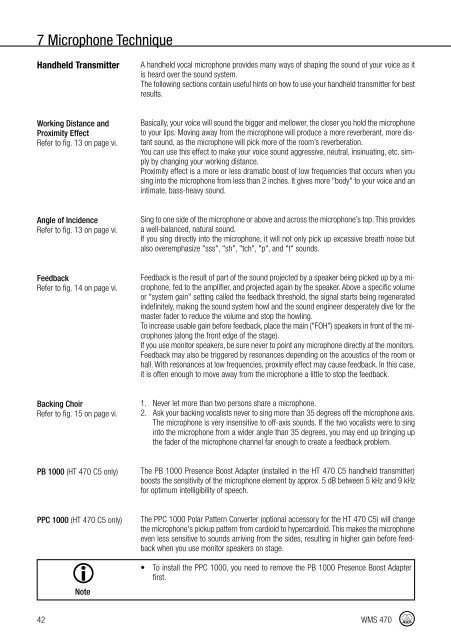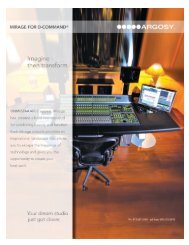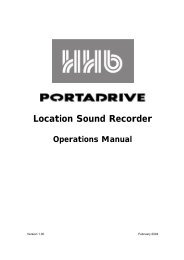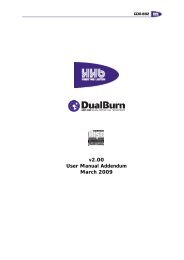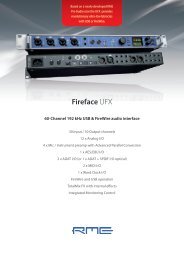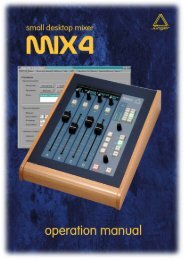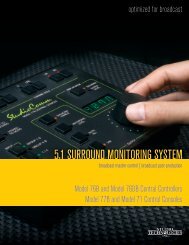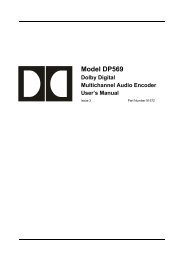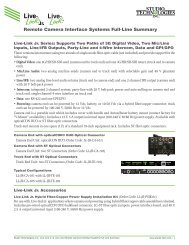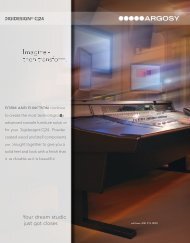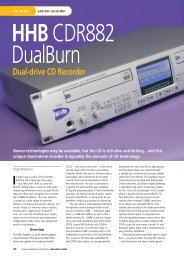WMS 450_korr_5.0
WMS 450_korr_5.0
WMS 450_korr_5.0
You also want an ePaper? Increase the reach of your titles
YUMPU automatically turns print PDFs into web optimized ePapers that Google loves.
7 Microphone Technique<br />
Handheld Transmitter<br />
A handheld vocal microphone provides many ways of shaping the sound of your voice as it<br />
is heard over the sound system.<br />
The following sections contain useful hints on how to use your handheld transmitter for best<br />
results.<br />
Working Distance and<br />
Proximity Effect<br />
Refer to fig. 13 on page vi.<br />
Basically, your voice will sound the bigger and mellower, the closer you hold the microphone<br />
to your lips. Moving away from the microphone will produce a more reverberant, more distant<br />
sound, as the microphone will pick more of the room’s reverberation.<br />
You can use this effect to make your voice sound aggressive, neutral, insinuating, etc. simply<br />
by changing your working distance.<br />
Proximity effect is a more or less dramatic boost of low frequencies that occurs when you<br />
sing into the microphone from less than 2 inches. It gives more "body" to your voice and an<br />
intimate, bass-heavy sound.<br />
Angle of Incidence<br />
Refer to fig. 13 on page vi.<br />
Sing to one side of the microphone or above and across the microphone’s top. This provides<br />
a well-balanced, natural sound.<br />
If you sing directly into the microphone, it will not only pick up excessive breath noise but<br />
also overemphasize "sss", "sh", "tch", "p", and "t" sounds.<br />
Feedback<br />
Refer to fig. 14 on page vi.<br />
Feedback is the result of part of the sound projected by a speaker being picked up by a microphone,<br />
fed to the amplifier, and projected again by the speaker. Above a specific volume<br />
or "system gain" setting called the feedback threshold, the signal starts being regenerated<br />
indefinitely, making the sound system howl and the sound engineer desperately dive for the<br />
master fader to reduce the volume and stop the howling.<br />
To increase usable gain before feedback, place the main ("FOH") speakers in front of the microphones<br />
(along the front edge of the stage).<br />
If you use monitor speakers, be sure never to point any microphone directly at the monitors.<br />
Feedback may also be triggered by resonances depending on the acoustics of the room or<br />
hall. With resonances at low frequencies, proximity effect may cause feedback. In this case,<br />
it is often enough to move away from the microphone a little to stop the feedback.<br />
Backing Choir<br />
Refer to fig. 15 on page vi.<br />
1. Never let more than two persons share a microphone.<br />
2. Ask your backing vocalists never to sing more than 35 degrees off the microphone axis.<br />
The microphone is very insensitive to off-axis sounds. If the two vocalists were to sing<br />
into the microphone from a wider angle than 35 degrees, you may end up bringing up<br />
the fader of the microphone channel far enough to create a feedback problem.<br />
PB 1000 (HT 470 C5 only)<br />
The PB 1000 Presence Boost Adapter (installed in the HT 470 C5 handheld transmitter)<br />
boosts the sensitivity of the microphone element by approx. 5 dB between 5 kHz and 9 kHz<br />
for optimum intelligibility of speech.<br />
PPC 1000 (HT 470 C5 only)<br />
i<br />
Note<br />
The PPC 1000 Polar Pattern Converter (optional accessory for the HT 470 C5) will change<br />
the microphone's pickup pattern from cardioid to hypercardioid. This makes the microphone<br />
even less sensitive to sounds arriving from the sides, resulting in higher gain before feedback<br />
when you use monitor speakers on stage.<br />
• To install the PPC 1000, you need to remove the PB 1000 Presence Boost Adapter<br />
first.<br />
42 <strong>WMS</strong> 470


